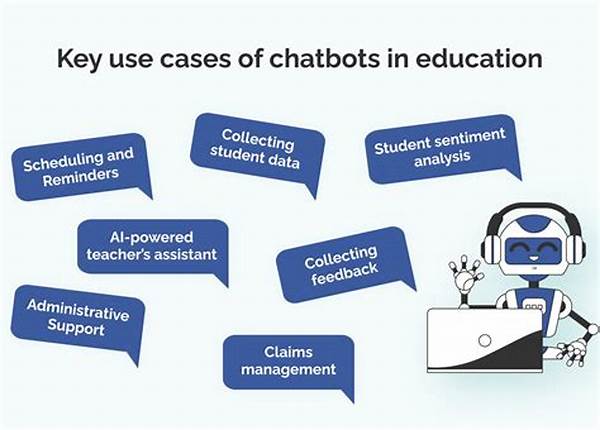The Rise of Chatbots in Education Technology
In recent years, the rise of chatbots in education technology has taken the education sector by storm, having a profound impact on how students learn and educators teach. Imagine a classroom where students can access round-the-clock support, and teachers can automate those routine tasks that previously consumed significant portions of their day. Not just a dream, this is a reality thanks to the developments in AI-powered chatbots. The dynamic nature of learning today demands that educational institutions and tech developers redefine how educational content is delivered. Chatbots promise personalized learning experiences, offer fast, reliable, and constant support, and create a bridge to more interactive and engaging learning environments. With today’s learners being more technology-inclined than ever, the education sector is forced to innovate, and chatbots stand at the forefront of this disruption.
Read More : Tambakbet Reveals Indonesia’s Plan To Embed Ai In School Curriculum
The transformative qualities of the rise of chatbots in education technology have made them an attractive feature for educational apps and platforms. From facilitating administrative processes to enhancing the student learning journey, chatbots are revolutionizing conventional education models. The capabilities of these AI tools include not only performing routine tasks but also providing tailored responses to student inquiries, hence promoting a personalized learning experience. Education has begun to benefit from achievements previously reserved for the corporate sector—cost savings, efficiency, and effectiveness are all impacts being felt in classrooms worldwide. In short, chatbots are opening the doors to previously uncharted territories in educational service delivery.
Chatbots have also managed to bring a humorous and engaging twist to learning. With features designed to interact conversationally, these bots can transform even the most mundane subject matter into something relatable and entertaining. Imagine a chatbot that tells a joke while helping you memorize historical facts, or one that mimics a celebrity voice to keep students engaged. The potential is limitless. Teachers can recreate lessons that feel bespoke and students find themselves more willing to engage with materials that adapt to their learning preferences. The rise of chatbots in education technology proves that effective learning doesn’t need to be dull or one-dimensional.
Beyond enhancing learning material and student interaction, chatbots also offer an insightful window into student performance metrics. The data collected by these AI systems can help educators tailor their teaching strategies to meet the unique needs of each student. An element of exclusivity comes into play here, as students receive the level of support and guidance akin to having a one-on-one mentor. It’s an exciting time for educational technology as we continue to unlock more doors using chatbots.
How Chatbots are Redefining Classroom Environments
Chatbots offer the opportunity to change classroom dynamics by replacing traditional rote memorization techniques with interactions that encourage critical thinking. This shift reflects the significant evolution from static, one-size-fits-all methods to dynamic, student-centered learning experiences. Chatbots serve not only as an informational resource but also as a conversational partner that aids learning, offering a good blend of education and entertainment. As we examine the rise of chatbots in education technology, the promise of these virtual assistants continues to inspire educators to think beyond traditional pedagogy and explore novel teaching methodologies.
—
Introduction
The rise of chatbots in education technology is not a mere buzzword but represents a sea change in how education is accessed and delivered globally. As we plunge deeper into the era of digital transformation, education systems worldwide have been pushed to adopt savvy tech innovations to keep up with the learning preferences of today’s digital natives. Chatbots are increasingly making their presence felt with a potential to alter not only how information is imparted but also how students are engaged.
Whether a student seeks instant help with homework at odd hours or a quick refresher before an exam, chatbots equipped with subject-specific knowledge are there to offer support. These digital tools operate around-the-clock, breaking down traditional learning barriers imposed by time constraints. They provide immediate responses, and their learning capabilities can adapt based on the inquiries they handle. The transformative potentials of chatbots are harnessed to optimize learning experiences, offering a bespoke educational approach that every student deserves.
Educators are also benefiting from the rise of chatbots in education technology as they offload routine administrative tasks such as scheduling, reminders, and grading. This newfound freedom offers educators precious time to focus on what they do best—teaching and mentoring students. Additionally, chatbots collect valuable data regarding each interaction, offering educators insights into student learning behaviors and helping them adjust their teaching strategies accordingly. The metrics collected can identify areas where students struggle, enabling timely interventions and personalized support.
The excitement surrounding the integration of chatbots lies not only in their functional benefits. Chatbots introduce a layer of engagement previously unseen in traditional education systems. Thanks to their conversational tone and dynamic responsiveness, students view them as more than just a tool. They become companions in the learning journey, always ready to assist and capable of encouraging curiosity-driven exploration. Students feel less apprehensive about making mistakes or asking questions, thanks to the judgment-free interactions with these AI-driven tools.
In the competitive landscape of educational technology, the rise of chatbots represents an opportunity for tech developers and educators alike. This synergy between technology and pedagogy holds the promise of more adaptable, inclusive, and engaging education systems. As more institutions look to increase accessibility and lower costs, chatbots emerge as a potent force in the realms of educational equality and efficiency.
Embracing Technology in Education
The growing dependency on education technology in academic environments signals a significant paradigm shift. Major technological innovations, like the rise of chatbots in education technology, are reframing educational objectives and evaluation metrics. This technological embrace promises better student outcomes by presenting education as a malleable, interactive domain rather than a rigid structure.
The Evolution of Learning Tools
Over time, education has seen diverse tools used to enhance learning—from chalkboards to smartboards, and now, chatbots. Each evolution brings with it a progressive understanding of how tech can be seamlessly integrated with pedagogy to improve student engagement and outcomes. The rise of chatbots in education technology is a crucial step in this continuum, providing educators with a versatile toolkit to meet contemporary educational challenges.
—
Key Features of Educational Chatbots
Chatbots have made an indelible impression on today’s education landscape by offering a suite of features that promote accessible, efficient, and customized learning experiences. As the rapid proliferation of digital tools continues, the role of chatbots will only expand, guaranteeing a future where quality education is within reach of every student, irrespective of geographical or socio-economic barriers.
With growing evidence supporting their benefits, the rise of chatbots in education technology is revolutionizing how learning is perceived and applied, ensuring that education remains an engaging journey rather than a destination.
The Impact of Chatbots on Education
The increasing integration of chatbots in educational settings underscores a broader acceptance of digital transformation in academia. As these virtual assistants continue to evolve, their impact on teaching and learning intensifies, highlighting the significance of innovation in education. The rise of chatbots in education technology marks a pivotal shift towards a more inclusive, adaptive, and interactive approach to learning.
Transformational Potential of Chatbots
Aside from immediate support and personalization, chatbots possess the unique ability to transform learning environments by adapting to each student’s pace and mastery level. This transformation extends beyond the classroom, empowering lifelong learning and skills acquisition tailored to individual needs. As the chatbot revolution gains momentum in education technology, it’s crucial that educators, developers, and stakeholders work collaboratively to maximize their potential.
—
Expanded Understanding of Chatbots
As we anticipate accelerated growth, chatbots’ role in educational frameworks will only deepen, cementing their place as indispensable tools for fostering holistic development within academic and personal contexts.
Exploring the Future of Chatbots
Despite their nascent stage, chatbots are poised to revolutionize educational interactions. Enhanced with AI capabilities, they foster environments conducive to critical and creative thinking. The rise of chatbots in education technology signals unparalleled opportunities for personalized learning and mentorship, breaking conventional barriers and embracing inclusivity in education.
Bridging the Education Gap
The potential of chatbots transcends traditional classroom walls as they offer a solution to education inequality by providing a uniform platform for knowledge acquisition. They promise to close gaps, providing all learners with the resources to thrive in an ever-evolving academic landscape.


